

Six Traits of Writing
The ultimate guide.
by Kristina Smekens

Kristina Smekens
Educational research states that all good writing includes six key ingredients:
- organization.
- word choice.
- sentence fluency.
- conventions.
These are the Six Traits of Writing.
But, as you’ve likely experienced, building stronger writers can seem overwhelming, regardless of the grade you teach. Every classroom includes a broad range of students at varying writing levels. As such, a canned writing curriculum will never meet the unique needs of every student.
That’s why our team believes so strongly in the 6 Writing Traits. It’s not a program. Instead, it is a framework that uses the six qualities of “good” writing to guide every lesson, assignment, and assessment.
If you want to learn what are the Six Traits of Writing, you’ve come to the right place! For nearly 20 years, we’ve been helping educators build stronger writers with the Six Traits. In this guide, you’ll find a comprehensive overview of the Six Traits of Writing. This includes suggestions for implementation in your own classroom.
Let’s get started!
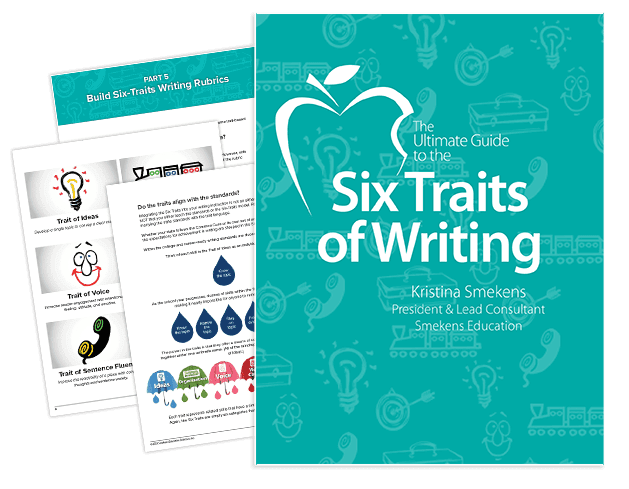
Don’t have time to read this now?
Enter your email address below and we’ll send you a printable version that you can reference later.
Table of Contents
PART 1: Get Acquainted with the Six Traits
PART 2: Get Started with the Six Traits
PART 3: Spiral through Trait-Based Lessons in Writing Units
PART 4: Provide Trait-Based Feedback
PART 5: Build Six-Traits Writing Rubrics
PART 6: Understand the Research Behind the Six Traits
PART 7: Implement the Six Traits School-Wide
PART 8: Acquire Six-Traits Tools & Resources
Get Acquainted with the Six Traits
What are the 6 traits of writing.
The Six Traits of Writing are rooted in more than 50 years of research . This research reveals that all “good” writing has six key ingredients—ideas, organization, voice, word choice, sentence fluency, and conventions.
These key components provide teachers and students with a common understanding for how to compose, revise, and assess all types of writing. They are inherent in well-written essays, reports, blogs, poems, videos, and other genres. And they make up the basis for what are the 6 traits of writing.
All 6 writing traits should be taught throughout grades K-12. They are evident within the products of our youngest writers through pictures, labels, lists, etc. In the upper grades, the traits can be found in all types of writing that occurs in English-language arts. When teachers utilize the Six-Traits language across the K-12 spectrum, it continuously reinforces what “good” writing is.
Many elementary educators have been tempted to divide the traits by grade level and teach only one trait per grade (e.g., First Grade: Ideas, Second Grade: Voice, etc.). But it’s important to bundle all six traits together so that each trait can be reinforced at every grade level. What changes at each grade is the complexity of the skills and the standards by which they are assessed.
As students master skills within each trait, introduce new skills such as:
- point of view,
- personification,
Even high school juniors and seniors can work toward mastery with new skills in each trait.
“Trait-based writing provides a common vocabulary for talking about writing.” – Ruth Culham
It’s important to recognize the 6 Writing Traits are not a program. They are simply six words, six characteristics, six ingredients inherent in strong writing. Therefore, this vocabulary integrates easily into any writing curriculum.
Let’s take a quick look at each of the 6 writing traits .
Trait of Ideas
Trait of Organization
Trait of Voice
Trait of Word Choice
Trait of Sentence Fluency
Trait of Conventions
Do the traits align with the standards.
Whether your state follows the Common Core or its own set of academic standards, the expectations for achievement in writing can be found in the Six Traits.

The power of the traits in writing is that they offer a means of collectively grouping many skills together under one umbrella name. (All of the raindrop skills above fall under the Trait of Ideas.)

While the Six Traits of Writing are inherently present in state and national standards and in all curriculums, it can take a critical eye to parse out individual sub skills and tie them to specific traits.
State Standards Organized by the Six Traits
Indiana 2023 Academic Standards color coded for the 6 Traits of Writing
Is “Presentation” the seventh writing trait?
The additional writing trait (6+1) addresses the presentation of the writing itself. In written pieces, this includes handwriting, penmanship, writing on a line, letter formation, and overall legibility. In digital products, it includes the use of typography, color, graphics, images, proportions, margins, white space, etc.
The trait of presentation deals with the overall visual appeal and look of the product.
Why is it called 6 + 1 and not 7 Traits of Writing?
Although the reader values the final look of the product, presentation does not weigh equally to the Six Traits. The Six Traits in writing identify the ingredients that impact the quality of the message. However, presentation doesn’t have the same impact on the message.
Oh, it’s true, the reader appreciates neat and legible writing. But, beautiful penmanship and a visually appealing layout, does not compensate for weak content.
The opposite is true, as well. A piece with an unusual font choice or a slideshow with distracting colors may give the reader a poor first impression. However, this does not reflect a writer’s ability. The content itself and the quality of that information are separate components.
Get Started with the Six Traits of Writing
How do i introduce the six traits to students, 1. be intentional.
Introduce Ideas
Introduce Organization
Introduce Voice
Introduce Word Choice
Introduce Sentence Fluency
Introduce Conventions
2. Be Consistent
Not only do you want to consider the pacing of your introduction but also the common thread. For example, when using a mentor text to introduce the Trait of Ideas, also use a mentor text to define each trait. If you use a song to introduce the first trait, you should use parallel songs to introduce all the other traits. A consistent or patterned approach to the introduction reminds students that the traits all work together.
3. Be Visual
Honor different learning styles. The more visual you can make your writing instruction, the more students you will reach. Consequently, introduce each trait verbally and visually with a purposeful graphic icon .
You can make your own icons, or you are welcome to download the Smekens Education Six-Traits Icons to get started right away. (TIP: When the entire school uses the same icons, students benefit from hearing the same trait language and seeing the same graphics from year to year.)
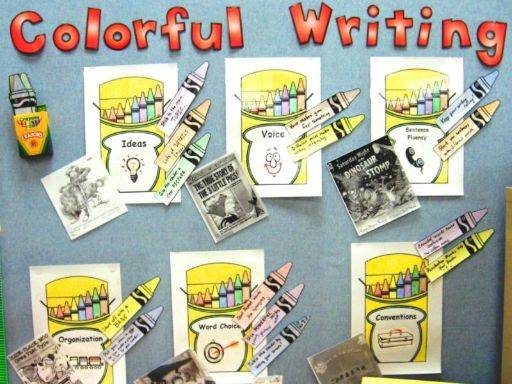
How do you teach the Six Traits of Writing?
The first days are spent introducing the six “umbrella” ingredients. However, the rest of the year is dedicated to teaching individual “raindrop” skills that fall under each trait and are required by the standards.
What to teach after introducing the Six Traits
Argumentative, persuasive, informative, and narrative writing all include the same 6 writing traits—but they each require different subskills. Remember, your yearlong writing instruction is not focused on “teaching the traits” but instead on teaching small skills within mini-lessons. The traits simply provide a way to organize those skills into logical order, with research-based categories.
- Organization in persuasive/argumentative writing includes a What & Why structure. The introduction identifies the topic or issue and the writer’s opinion, claim, or stance on it. The middle paragraphs then develop the reasons and evidence to explain why.
- Organization in how-to informative writing includes a chronological structure. The introduction identifies the topic or concept, and the body describes the individual steps to achieve it. (NOTE: There are many other genres and text structures for informative writing. This is just a single example.)
- Organization in narrative writing includes a Who, What, & How structure. The beginning introduces the character (i.e., who), the middle reveals the problem (i.e., what), and the end explains how it was resolved.
Spiral through Trait Lessons in 6 Trait Writing Units
Skills to teach in a 6-traits mini-lesson, trait of ideas mini-lessons.
- Knowledgeable writing topics
- Writing for a purpose
- Narrow topic
- Details, development, & elaboration
- Supporting ideas with examples
- Develop plot, characters, setting
- Trait of Organization mini-lessons
Pre-writing & planning
- Beginning, middle, and end
- Like ideas clumped together
- Hook and ending components
- Clear transitions
- Sequential ideas
Trait of Voice mini-lessons
- Writing to an audience
- Reader-writer connection
- Writer’s feelings about the topic
- Voice expressed with type ( NO , !!!, yuck )
- Shifting attitudes within a piece
- Perspective
Trait of Word Choice mini-lessons
- Specific nouns (right word, right spot)
- Adjectives (descriptions, 5 senses)
- Action verbs
- Imagery (show, don’t tell)
- Synonyms (varied word choice)
Trait of Sentence Fluency mini-lessons
- Complete thoughts; complete sentences
- Different sentence beginnings
- Sentence types (.!? simple, compound, complex)
- Varied sentence lengths
- Readability; easy to read aloud
- Figurative language
Trait of Conventions mini-lessons
- Proper use of capital letters
- Paragraph indents
- Grammar & mechanics
- Punctuation (,;—’…”)
- Readable spelling
- Word spacing and wrapping
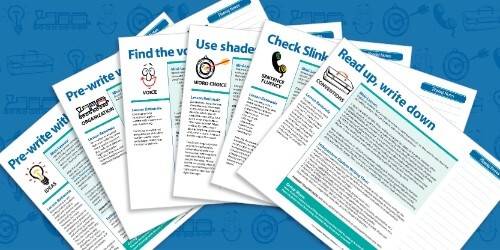
Get Six Free Lessons
Organize your teacher resources by trait.
Since every writing skill falls under one of the Six Traits, it makes the most sense to organize your lesson materials and resources by trait—not by writing unit.
- If you are looking to organize digital documents, then establish six folders on your computer—one per trait.
- If you prefer organizing paper-based resources, create an old-fashioned filing system with six folders or a set of six three-ring binders. (We developed Six-Traits mini-lesson labels to adhere to the outside of expandable hanging file folders . Use the list of skills printed on the label as a guide for collecting and organizing trait-based mini-lessons.)
Regardless of the organizational method you choose, house individual lesson plans, resources, and writing samples within their broader trait categories for easy access.
How to deliver a Six-Traits mini-lesson
Best-practice mini-lesson instruction always contains four essential steps.
STEP 1: Introduction
Step 2: instruction.
More than just telling students what to do, this is when the teacher shares her expert thinking to reveal when, where, how, and why you do it. This personal journey of thoughts accompanies the teacher’s live demonstration of the skill . It’s the pre-planned, one-person monologue, where the expert captions every action being demonstrated. This added component reshapes this teacher-demonstrated portion to include I do, you watch and listen .
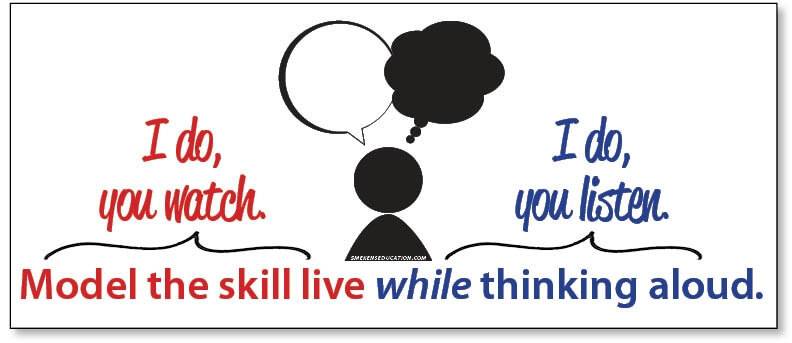
To ensure efficient and effective Think Alouds , apply these tips:
1. Announce lessons will include an I do portion. This is the time where the teacher demonstrates, and students watch and listen. (For those eager to share, remind them not to help you but to assess if they are thinking what you are thinking.)
2. Do not make eye contact with the students. Instead, look above them, beyond them, or through them. This reinforces that the I do is a one-person monologue.
3. Speak in the first person. Rather than questioning What could you do? speak about what I could do . Use only I, me, and my statements during a Think Aloud .
4. Plan out every Think Aloud. Although teachers know how to execute various writing skills, most don’t know how they know how to do it. They just do it!
Since the skill is so automatic, it requires teachers to slow down and carefully consider their thinking process before attempting to teach it to students. If the Think Aloud isn’t planned out ahead of time, it’s easy to overgeneralize the process and return to telling and cease truly teaching.
STEP 3: Interaction
Although this interaction step includes student participation, it’s important not to lose control. Rather than calling on individuals during the mini-lesson, engage all students with opportunities to think through the skill. Use code phrases like “Turn & Talk” and “Back to Me” to let students know when to pool their thinking with a peer and when to return their attention to instruction.
The challenge of getting every student involved in the learning is not a new one. The fact of the matter is, some students don’t have the desire, the confidence, or the skill set to actively participate collaboratively.
During our professional development for teachers, we have long encouraged the “Turn & Talk” strategy to engage students in peer collaboration as they respond to a question prompted by the teacher. However, this procedure needs to be taught, practiced, and fine-tuned.
STEP 4: Closure
Step 4 closes the mini-lesson and sets students up for a response activity. After the I do (Step 2) and the We do (Step 3), it’s time for the You do (Step 4). Identify what you want students to do with the skill on their own. While writing today, I’d like you to. . .
Remember, the students don’t get better during the lesson—it’s after the lesson when they practice the skill that they improve their abilities. Consequently, keep the lesson short.
How do I make trait-based writing lessons more engaging?
Boost engagement with concrete triggers.
Increase student engagement during a Six-Traits mini-lesson by incorporating a trigger . Not only do visual aids add a level of energy and excitement, but they also help students remember the purpose and function of specific writing skills.

FREE RESOURCE
The Power of Physical Triggers
For example, when teaching students to write about a narrow topic (or focused thesis statement), the goal is to show them how to go from a large, broad subject to something smaller, more finite. It’s all about shrinking the topic.
Everyday items that get smaller are Russian stacking dolls, Tupperware, and nesting boxes. Reveal one of those objects within the lesson to demonstrate how a large subject can be narrowed down to a smaller, more focused topic.
Integrate mentor text
Step 2 of a mini-lesson often includes revealing examples of the skill in action. Although workbooks and worksheets include examples, they are typically contrived and formulaic and lack the quality and sophistication of authentic sentences. Mentor text reveals the skill within real-world writing.
- Consider sharing picture books with your students to demonstrate a specific trait. Even middle school and high school students enjoy picture books!
- Look for excerpts from chapter books and novels that exemplify a specific writing skill.
- Collect authentic text (e.g., newspaper articles, websites, cartoons, etc.) to show students that current trends in writing include the traits in writing.
- Use student anchor papers to convey what “good” writing looks like for a specific assignment.
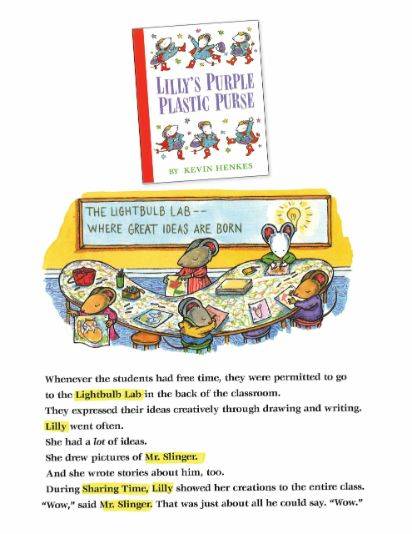
Do I teach a new skill every day?
No, you do not teach a new skill every day. You teach a mini-lesson every day, but the same skill will be taught across multiple days.
Teach one skill across 3+ days

Mini-Lesson Planning Template
The first mini-lesson focused on studying the skill as a reader. Day 2 transitions to Try It as a writer. Instruction must include the teacher modeling how to return to a previous draft and insert the skill in context. This will again require Thinking Aloud during the lesson .
Provide Trait-Based Feedback
One of the most powerful aspects of the Six-Traits language is its application beyond instruction. Provide writers with clear feedback within formative assessments and daily conferences utilizing the same six ingredients of good writing.
How do I use the Six Traits to offer feedback?
Engage in trait-based writing conferences.
Literacy expert Carl Anderson has done extensive work in the area of writer conferencing. He claims that conferring with students is a teacher’s most crucial writer’s workshop role. This type of formative assessment reveals the skills students are mastering but also what they need next instructionally.
Conferring with students is nothing new, and most teachers agree on the benefits of conferencing. However, this facet of writing can often be grueling for teachers. It’s important to understand that there are different types of conferences that each serve a unique purpose.
Product Conferences
The notion of conferencing often includes a long, laborious meeting with one student at a time at a separate table or at the teacher’s desk. Such a conference is called a product conference as the teacher will spend 15-25 minutes with an individual student going over all parts of his piece.
The advantage of this meeting is that the teacher can point out numerous strengths and numerous areas for improvement in preparation for a final draft. While spending all this time with one student is powerful, the other 25 kids lack teacher feedback and support for a long time.
“We are not editors, but teachers. The goal of a conference is to help students become better writers.” – Carl Anderson
Process Conferences
Students need feedback during all stages of the writing process—not just during the final revision and editing stages . Unlike the longer product conference, a process conference lasts only a few minutes, and it can happen at any stage in the writing process. Teachers may sit down with students and talk about choosing a topic or discuss their pre-writing plan or give feedback as they draft a new piece or when they’re fine-tuning it.
Students would rather have a few minutes of teacher feedback regularly versus 20 minutes once a month. They need to be in touch with the teacher more often, but they do not necessarily need to be one-on-one. Leading a process conference with small groups of students allows more students to receive feedback more often.
Group process conferences allow teachers to touch base with more students each day and provide a critical, formative assessment of where students are and what they need next.

Provide students with compliments & comments
Build six-traits writing rubrics, build a kid-friendly six-traits writing rubric.
Often teachers draft a rubric on their own and then “go over” it with the kids. However, with this approach, students have little ownership and may not understand some of the rubric language.
Consequently, create a writing rubric with your students . Since the criteria and language are generated by the students, this ensures that it’s a kid-friendly assessment tool. Furthermore, this method honors the education research . Here’s the process for building a Six-Traits rubric with students:
- HIGH: Work together to describe what each trait looks like within a “good” one.
- MIDDLE: Then, consider a “pretty good” writing piece—one not as strong as the HIGH but not LOW either. This MIDDLE level must include parallel criteria described in the HIGH level.
- LOW: Repeat this process describing the qualities and characteristics of a LOW-level product.
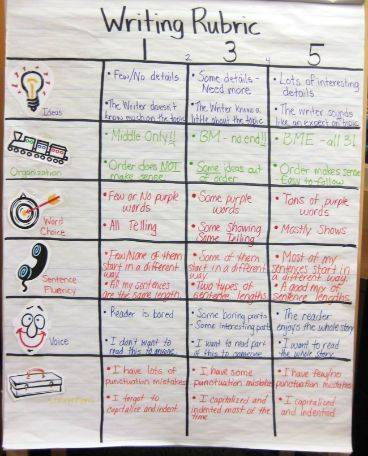
Provide individualized feedback using the rubric
With a kid-friendly Six-Traits rubric, you can provide students with individualized feedback on their writing. But contrary to popular belief, providing precise feedback to student writers does not have to involve an all-encompassing critique with the red pen. After creating/updating the rubric with students, use this tool to do the majority of the work. Accompany each piece of writing with a copy of the rubric.
After creating/updating the rubric with students, use this tool to do the majority of the work. Accompany each piece of student writing with a copy of the rubric.
- Instead of writing Add more detail or Fantastic verb choice in multiple places on the student’s draft, simply highlight those criteria within the rubric.
- Next to the highlighted criteria, include specific words or paragraph numbers the comment pertains to.
- Using the annotated rubric , students apply your customized comments and compliments in revision.
This approach helps teachers transition from simply fixing student writing to focus on building writers .
Use a Six-Traits writing rubric to assign grades
This same kid-friendly analytic Six-Traits rubric can be used to generate grades as well. However, it’s important to adhere to these three guiding principles :
1. NO ONE CAN FAIL ON THE RUBRIC. Students earn a failing grade if they do not attempt the assignment (i.e., do not turn it in). However, submitting a product must qualify them for at least a D-. If a weak attempt is valued the same as no attempt (i.e., failing), then many students stop trying. Therefore, the lowest score on the rubric, a Level 1, needs to be within a passing range (e.g., 60% or D-).
2. HONOR THOSE WHO GO BEYOND THE GOAL. Include at least one level that describes a product that knocks your socks off. Have an A level (Level 4), but then have an exceeding or A+ level (Level 5).
3. DON’T WEIGH TRAITS EQUALLY. Depending on the piece, different traits are emphasized. If students are only writing a first draft, then conventions would likely weigh less than the traits of ideas and organization.
However, in poetry, word choice and sentence fluency might be valued more. Identify the traits you want to score and the point value that coincides with where you spent your instructional time.
Convert Six-Traits rubric scores to a grade
How to use the six-traits rubric calculator:.
1. Identify which traits you want to score. 2. Determine the value you want to give each one 3. Read a student’s piece. 4. Click each individual trait score based on rubric criteria. 5. Click to calculate the earned grades, points, and percentage for your grade book.
Six-Traits Rubric Calculator
How do the 6 traits of writing fit within state writing rubrics.
The power of the Six-Traits writing framework is its universal application to every grade level, writing genre, and student writing assessment. Although ideas, organization, voice, word choice, sentence fluency, and conventions are the essential traits that are embedded in all state and national testing rubrics , they are not necessarily labeled by those names.
Six Traits within state writing rubrics
Kentucky On-Demand Writing Rubrics ( Grade 5 , Grade 8 , Grade 11 )
Understand the Research Behind the Six Traits
Where did the traits come from.
In the 1960s, a researcher named Paul Diederich asked a group of professionals to identify what makes writing effective. He received hundreds of responses, ranging from strong metaphors to correct semicolons. But no one can remember hundreds of things simultaneously, so Diederich grouped the responses and found they fell within six categories.
In 1984, literacy expert Vicki Spandel led a team who replicated Diederich’s study. In the end, Spandel, curriculum experts at the Northwest Regional Education Laboratory, and willing teachers from Missoula, Montana and Beaverton, Oregon all settled on the same six ingredients.
Since that time, the research has been formally conducted a third time. Using an even wider variety of writing genres, including digital and online writings, Education Northwest has proven that the same six ingredients are still the core of “good” writing.
The Six Traits of Writing model is now used in all 50 of the United States as well as multiple countries around the world.
Traits Writing: The Gold Standard of Writing Instruction and Assessment
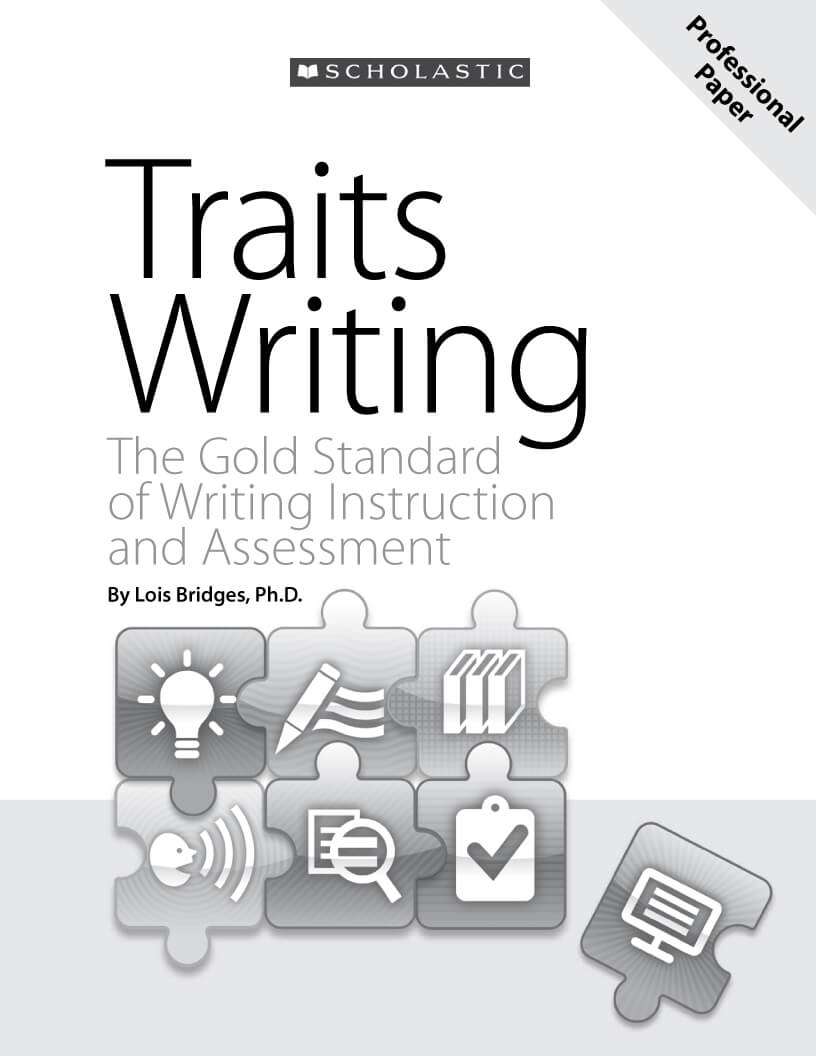
An Investigation of the Impact of the 6 + 1 Trait Writing Model, December 2011
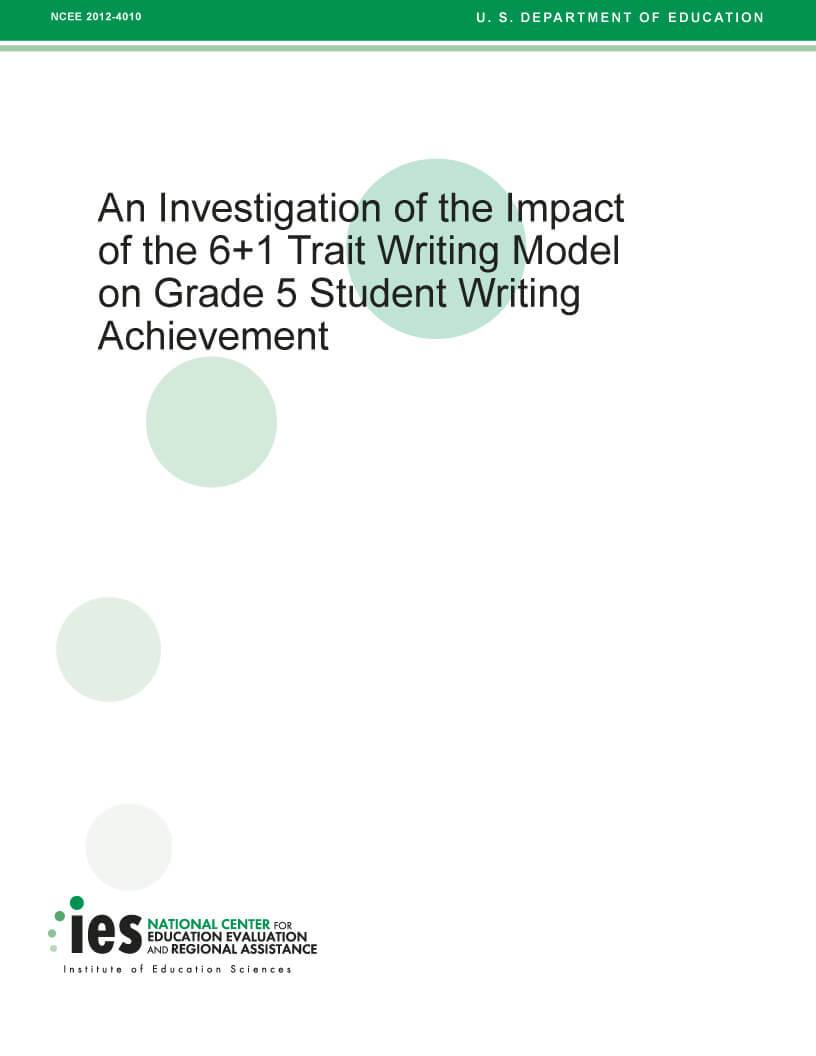
Implement the Six Traits School-Wide
When a K-5 school, for example, commits to Six-Traits implementation, students at every level are exposed to age-appropriate mini-lessons, mentor text, anchor papers, and writing rubrics—all of which are intentionally tied to the Six Traits. That consistent exposure to the same elements over a period of years strengthens students’ depth of knowledge but also their capacity to apply the traits in writing. This includes persuasive, argumentative, informative, and narrative pieces.
Six-Traits Professional Development
Most English/language arts textbook publishers are intentional about labeling their resources with the Six-Traits language. But too often, boxed curriculums lack the depth and intentionality that is required in order to fully implement the Six Traits.

In order to know how to launch and execute a fluid Six-Traits model that is responsive to student needs, teachers need the support of ongoing professional development. After all, most teachers didn’t learn how to teach writing in college, making vague guidance from the language arts textbook a recipe for shallow writing instruction. Using professional development as a catalyst to school-wide implementation of the Six Traits involves a continued cycle of professional learning, practice, and collaboration.
Six-Traits Professional Learning
Initial professional learning on the Six Traits should focus on building a shared understanding of not only the six words, but more importantly, what the traits look like in all genres and at each developmental level (i.e., pictorial writing in grades PK-1 ).
Chances are, teachers are already using the traits in one form or another. (Remember, the traits are inherent characteristics of good writing. Consequently, teachers are already targeting many of these individual writing skills. They just aren’t taking advantage of the power and prioritization that comes from grouping them by the six words.)
With this in mind, the first focus of professional learning is to identify what teachers already know about good writing and marry it with the Six-Traits framework. Teachers will be put at ease when they realize they don’t have to abandon all that they are already doing.
After a baseline understanding has been established for teachers, the next step is to reveal strategies for introducing the trait language to students. It’s important for teachers to learn classroom-tested techniques. This includes how to use characters, picture books, graphic icons, songs, or a combination of these tools to launch an intentional introduction of the Six Traits. This sets the stage for a yearlong sequence of trait-based writing lessons tied to different modes and genres.
Professional learning can occur in many forms. But the more frequent and firsthand learning teachers experience, the better the chances that the Six-Traits framework will be implemented school-wide. There are several ways to engage entire staffs with Six-Traits professional learning:
1. Get the ball rolling with a book study that examines the foundations of the Six-Traits framework. Great starter titles include Ruth Culham’s books, 6+1 Traits of Writing: Primary Grades , 6+1 Traits of Writing: Grades 3 and Up , and Traits of Writing: The Complete Guide for Middle School .

4. After teachers have embedded the Six Traits into their writing lessons, assignments, and assessments, engage teams in instructional rounds. This activity allows educators to observe their colleagues deliver trait-based instruction and then collaborate afterward to offer feedback and encouragement.
5. Use PLC time to examine how the Six Traits are being implemented and how learning is ultimately being impacted. As learning gaps are identified throughout the school year, use professional learning tools such as Smekens Education’s webPD . This will provide teachers with innovative strategies to address specific writing weaknesses.
Acquire Six-Traits Tools & Resources
Identify your next steps.

View our Six-Traits on-demand workshops

Access free resources on the Learning Center
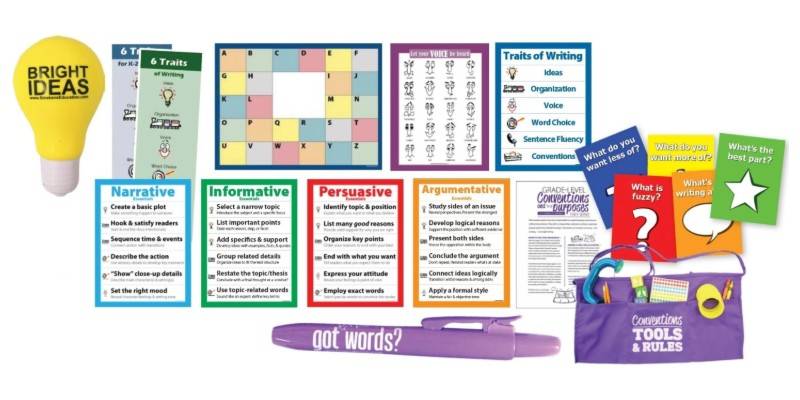
Get Six-Traits classroom triggers, posters, & resources
Get the essential bundle of Six-Traits Smekens Originals—teacher-friendly resources to help you implement the Six Traits. This discounted bundle is a cost-effective way to embed trait language into your classroom environment and your instruction.
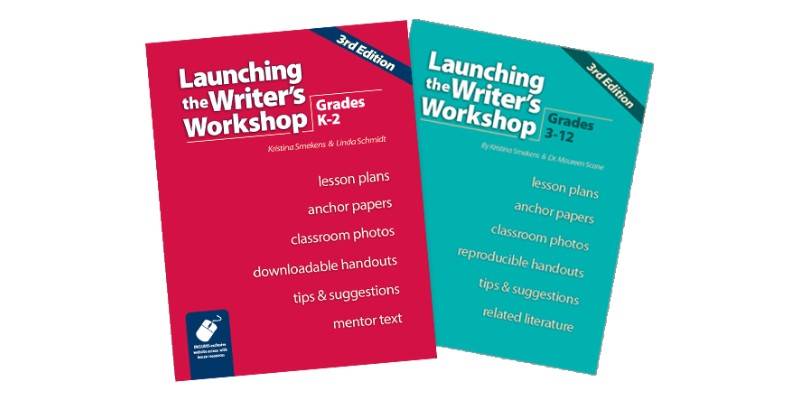
Get trait-based lessons & resources
Our best-selling resource, Launching the Writer’s Workshop is packed with more than 50 explicit trait-based lessons and resources. Lessons will help you establish a writer’s workshop, introduce the traits, and target essential writing skills throughout the school year.
Final thoughts
Ready to Learn More?
6 Traits of Writing
Characteristics, Definitions, and Activities for Each Component
Janelle Cox
- Classroom Organization
- Reading Strategies
- Becoming A Teacher
- Assessments & Tests
- Secondary Education
- Special Education
- Homeschooling
- M.S., Education, Buffalo State College
- B.S., Education, Buffalo State College
The six traits of writing model provides a recipe for successful prose writing. This approach defines the ingredients of effective writing for students to practice and teachers to assess, equipping both parties with tools for strategically analyzing written work.
Students can become self-sufficient and methodical writers when they learn to develop the following characteristics in their writing. To take advantage of this revolutionary model, learn what the six traits are and how to teach them.
What are the Six Traits of Writing?
The six key characteristics that define high-quality writing are:
Organization
Word choice, sentence fluency, conventions.
Please note that while this method is often called the 6 + 1 Trait Model, the plus one "presentation" trait is largely optional as it is a characteristic of the overall product and not the writing itself. This trait will not be described further here.
This writing component captures the main idea of a piece through detail. Only details that are relevant and informative of the main topic should be included. Strong writers have an awareness of how to use just the right amount of detail, using ideas that make the overall message more clear and leaving anything out that takes away from it.
How to Teach:
- Do an exercise with students where you tell a story using no detail while they close their eyes. Could they picture it? Ask them how to improve your story and introduce the concept that ideas need to be supported to be effective.
- Ask students to describe what is happening in a photograph. Have them do this in partnerships where only one partner can see the picture at a time and the other must convey the message of the photo in front of them.
- Have students compose a paragraph packed with as much supporting detail as possible. Tell them to choose a specific (true) event that happened to them and use their senses to describe it.
This trait describes how all ideas in a piece of writing must fit together within a larger message. The organizational structure of a written work needs to follow a clear pattern such as chronological order for narratives or logical order for informational writing. The writer needs to make strong connections from one point to another so that a reader can easily follow along. A sense of sequence is necessary for organizing.
How to Teach
- Take a piece of writing and cut it into chunks, having students piece the writing back together as best as they can.
- Jumble a list of directions and have students arrange the steps in order.
- Read two short informational books whose organization structures vary. Ask your students what is different about the organization of the books.
This trait describes the unique style of each writer. Through voice, a writer's personality permeates a piece but does not detract from the genre or message. Strong writers are not afraid to express their individuality and show readers their point of view. Good writing sounds like its writers.
- Discuss the personality traits of a few children's book authors, then read a variety of literature and have students try to identify the author by voice.
- Compare and contrast the voice in select fiction and nonfiction books.
- Have students write a letter to a grandparent about their favorite school subject. When they are finished, discuss how they cultivated their voice in the letter and whether they feel that their thoughts and emotions came through.
Word choice describes the effectiveness of each word in a piece of writing. Strong words enlighten readers and clarify ideas but too many large or misplaced words can muddle the message. Great writing is never verbose. Writers should be economical with their words and choose only the best ones because every word is important. Linguistic awareness and a robust vocabulary are necessary for effective writing.
- Keep a word wall, adding to and discussing it frequently.
- Show students a paragraph with words missing. Offer options for words to put in the blanks and explain why some of them are better than others.
- Introduce students to thesauruses. Teach that a well-rounded vocabulary is useful but caution against overdoing it by having them first replace as many words as they can in a paragraph and then only words that make sense to replace.
This trait describes the smoothness that sentences contribute to a piece. Fluent writing is rhythmic and forward-moving because its sentences are easy to read. Even more important to sentence fluency that correctness and grammar are meaning and variety. The best writers make sure that each of their sentences says precisely what it is supposed to say and vary their sentence structures so that they don't all resemble each other.
- Write a story where every single sentence begins and ends in the exact same way. Talk with your class about why this is problematic and have them help add variety to the sentence structures.
- Rearrange the sentences in a popular piece of writing. Have the students fix it and talk about why it matters that sentences flow easily into each other.
- Have students take a sentence in a piece of informational writing and flip the words around. Does it make more or less sense? Is their way better or worse?
This trait focuses on the correctness of a piece in terms of spelling, grammar, punctuation, and other rules. Writing can only be great if it is technically correct. Great writers are proficient punctuators, capable spellers, and grammar savants. Conventions require time and patience to master but are easy to practice.
- Give your students a word to correctly work into a sentence. Begin with simple sentence parts such as subjects and verbs and progressively get more difficult with adverbs, adjectives, and more.
- Teach students to peer review each other's work for correctness. They do not need to correct every tiny detail. Rather, focus on one skill at a time (punctuation, capitalization, etc.).
- Use curriculum materials such as handouts and mini-lessons to teach conventions.
- Nast, Phil . “6 + 1 Trait Writing.” National Education Association .
- “What Are the Traits?” Education Northwest , Dec. 2012.
- 7 Buzzwords You're Most Likely to Hear in Education
- The Writer's Voice in Literature and Rhetoric
- 6 Steps to Writing the Perfect Personal Essay
- 10 Learning Strategies to Use in Your Classroom
- 11 Quick Tips to Improve Your Writing
- How to Teach Topic Sentences Using Models
- How to Teach English Using Newspapers
- Cartoon Strip Social Interactions
- How Dyslexia Impacts Writing Skills
- Stylistics and Elements of Style in Literature
- Conceptual Meaning: Definition and Examples
- What Is Tone In Writing?
- revision (composition)
- Word Choice in English Composition and Literature
- Activities to Practice Decoding Skills for Reading
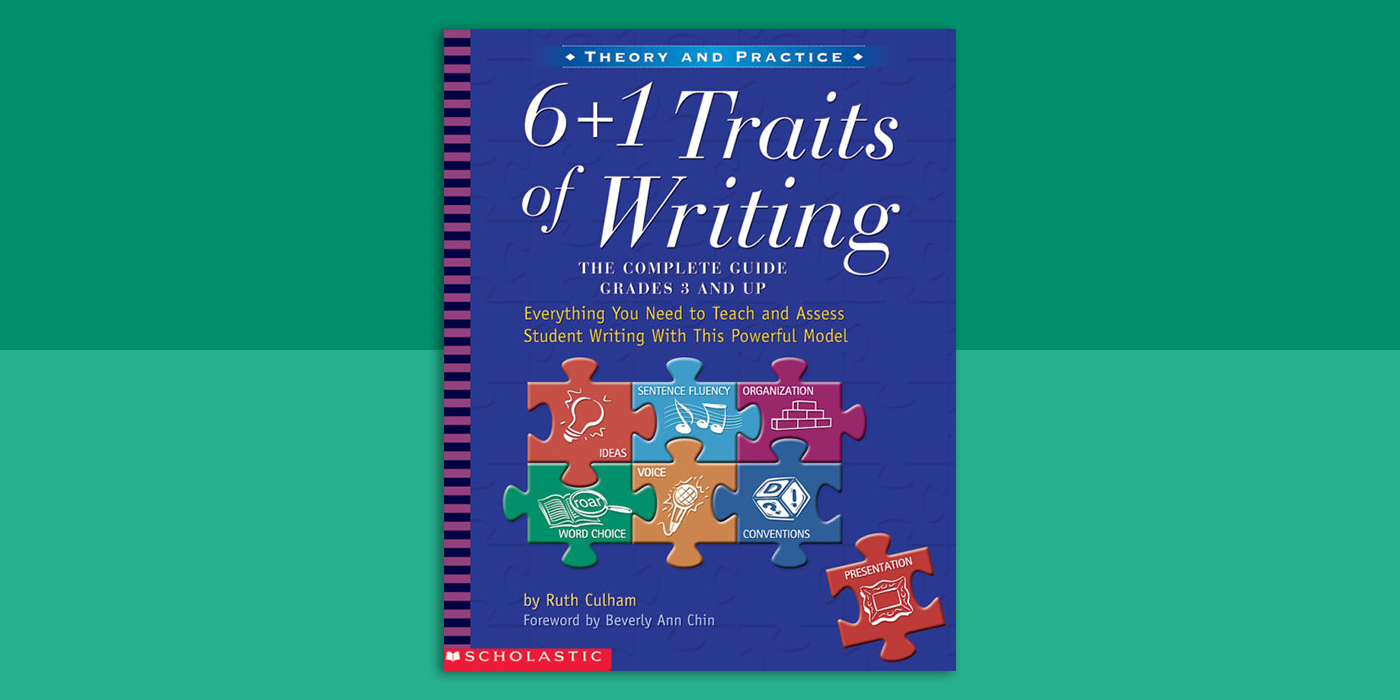
How the 6+1 TRAIT Model Improves Students' Writing
In 6+1 Traits of Writing: The Complete Guide: Grades 3 and Up , I outline how the 6+1 TRAIT model is more than an approach to teaching and assessing writing. It’s a vocabulary that teachers use to describe their vision of what good writing looks like—any kind of writing. Whether it’s a story about a quirky music teacher, an essay on the effects of global warming, or a persuasive piece on why Harry Potter books should be in every school library, certain characteristics—or traits—make the writing work: ideas, organization, voice, word choice, sentence fluency, conventions, and presentation. Using the language of the 6+1 TRAIT model in our assessments gives us a shared vocabulary for speaking about and working with texts that students create.
The 6+1 TRAIT model is also form of analytic assessment, a method of looking at the main characteristics of writing and assessing them independent from one another. From its early conception to its present form, this model has provided classroom teachers with a powerful tool for communication about writing performance, one that far exceeds the limited information a single grade or score provides. By clearly defining the qualities of good writing, and helping teachers use that knowledge in the classroom, the model ensures that students receive useful feedback to improve their writing as it develops.
Student writing improves when the traits are used in a systematic way in the classroom and throughout the school. We must build curriculum that maintains a shared view of what “good” writing looks like that remains constant throughout the school years, K to 12. If expectations for students’ work keep building one year to the next, based on the same core criteria, we save valuable time reviewing and revising curriculum, which allows infinite opportunities for growth.
All writers need specific and direct feedback on their work, regardless of their stage of development. It’s important to explain to writers, or help them discover for themselves, the reasons a piece is or isn’t working and what to do about it. For those who have done a fine job, we want to realize that this is more than a happy accident, and that by recognizing the traits of success in their work, they can do it again and again. For those who are struggling, we want them to understand that writing is hard, but if they know what they are shooting for and have consistent and honest feedback, their work will improve with every attempt—and that’s no accident, either.
To learn more about 6+1 Traits of Writing: The Complete Guide: Grades 3 and Up , you can purchase the book here .
About the author:
Ruth Culham, Ed.D., has published more than 40 best-selling professional books and resources with Scholastic and the International Literacy Association on the traits of writing and teaching writing using reading as a springboard to success. Her steadfast belief that every student is a writer is the hallmark of her work. As the author of Traits Writing: The Complete Writing Program for Grades K–8 (2012), she has launched a writing revolution. Traits Writing is the culmination of 40 years of educational experience, research, practice, and passion.
How to Help Students Incorporate Their Voice Into Writing
Voice emerges when the writer approaches the topic at an emotional level. One sure way to help students do that is through music. Whether it’s an old classic that they’ve heard over and over or something contemporary, music reaches deep inside all of us and helps us to feel. This activity from 6+1 Traits of Writing: The Complete Guide Grades 3 and Up will help students recognize voice and inspire them to incorporate it into their own writing:
What To Do:
- Find 3 to 5 different versions of a popular song that has been recorded by different artists over the years. (Beatles’ songs are a good place to start!)
- Before you play the original version of the song, tell students all you know about the song: when it was recorded, by whom, and so forth. Then ask them to close their eyes and just listen to the recording.
- Play the piece again, only this time ask students to record any feelings, emotions, connections, and images that may occur to them. Ask them to keep a running list of the words that describe the voice of the piece: “thoughtful,” “moody,” and “caring,” for example.
- Have students put their first collection of words aside, play another version of the same song, and ask them to list their thoughts again. It’s important for students to hear each piece a couple of times to truly appreciate the differences between the songs.
- Now play the other versions—as many as you can find. As students listen to version after version, their papers should fill with words describing what makes each one unique.
- As a class, record on the blackboard or on chart paper the different voices students heard for each rendition.
- Discuss the various responses and the role of voice in each recording.
- Challenge students to summarize each rendition in a sentence that captures the essence of its voice.
Follow up with more discussion by asking students how listening to music is like reading somebody’s writing. Let them talk or write out their ideas and be sure to allow plenty of time to share. You’ll be amazed at the depth of their understanding. And once students see voice as a powerful tool to make their writing stronger, they will look for ways to add it on their own.
Find more activities to teach students the 6+1 TRAIT model of writing with 6+1 Traits of Writing: The Complete Guide Grades 3 and Up . You can purchase the book here .

- Terms of Use
- Privacy Policy
- Internet Cookies
- Instructional Exchange
- Educator's Toolkit
- Ayers Exclusives
- Tennessee Tools
- Education Events
- Conference Materials
- Crosswalk Charts
- Podcast Resources
- Webinar Sessions
6+1 Traits of Writing: PowerPoint
This web link provides numerous PowerPoint presentations on the writing process. The sixth one down specifically focuses on the 6+1 Traits of Writing. The link provides many other PowerPoint presentations concerning the writing process that can also be helpful in classroom instruction.
Click on the PowerPoint of your choice. It will be brought up in a Microsoft PowerPoint presentation.


6 + 1 Writing Traits
Jul 27, 2014
220 likes | 493 Views
6 + 1 Writing Traits. Lindsey Shreck Towson University Spring 2012. Objectives. Participants will… Use words and pictures to define the 6 + 1 traits of writing Identify strategies to use in the classroom to support the 6 + 1 traits of writing
Share Presentation
- small group members
- early childhood educational
- group members
- northwest regional educational laboratory
- age tutoring
- word choice

Presentation Transcript
6 + 1 Writing Traits Lindsey Shreck Towson University Spring 2012
Objectives Participants will… • Use words and pictures to define the 6 + 1 traits of writing • Identify strategies to use in the classroom to support the 6 + 1 traits of writing • Use the 6 + 1 traits rubric to assess sample writing pieces Lindsey Shreck Spring 2012
Pre-Assessment Turn and Talk: • What process do your students complete to create a writing piece? • How do you conference with your students during writing? • Do your students use checklists during writing? If so, describe its purpose? • How do you assess your students’ writing? Lindsey Shreck Spring 2012
Background Research • Choice, time, and feedback are important elements in teaching children to write effectively (Higgins, Miller, & Wegmann, 2006). • To address the need for effective feedback, an analytic scoring system was developed by a group of teachers in the early 1980s. The Northwest Regional Educational Laboratory (2004) identified six key qualities that define strong writing. These qualities are ideas, organization, voice, word choice, sentence fluency, and conventions. Lindsey Shreck Spring 2012
WRITING TRAITS • Voice • Is my writing different from everyone else’s? • Have I added some sparkle? • Does the writing sound like you? • Ideas • Did you choose an interesting topic? • Did you support your ideas with juicy details? • Are your ideas clear? • Organization • Does it have a clear beginning? • Does it have a middle where details are in clear order? • Does it have an ending? Lindsey Shreck Spring 2012
WRITING TRAITS • Sentence Fluency • Does the writing flow? • Does each sentence have a subject and verb? • Does each sentence begin with a different word? • Word Choice • Is my writing different from everyone else’s? • Have I added some sparkle? • Does the writing sound like you? • Conventions • Is the spacing correct between the letters and words? • Is the spelling readable? • Are capitals at the beginning of sentences and punctuation at the end? • Presentation • Is it neat and legible? • Is their balance between text, pictures, and white space? • Are there margins around the edges of the paper? Lindsey Shreck Spring 2012
6 + 1 Traits in Action Watch and Ponder: • What language did the teacher use • What resources did the teacher use? • What were the children doing? • Video clip of sentence fluency mini-lesson ( I will be attaching a video clip of myself modeling a lesson) • http://www.youtube.com/watch?v=S6BEyUmtUZ4 • http://www.youtube.com/watch?v=yldtbXSAd5Y Lindsey Shreck Spring 2012
Research Support • “Beginning writers benefit from trait-driven instruction because the traits are specific, are easily taught and reinforced, and make sense.” (Culham, 2005, p. 15). • Through mini-lessons, students are taught how to assess their writing by the definitions of the six traits (Higgins, Miller, & Wegmann, 2006). Lindsey Shreck Spring 2012
Why Teach 6 + 1 Traits? • It is imperative for students to have specific and constructive feedback in the writing classroom so that they are knowledgeable about what their strengths are and what areas need improvement (Culham, 2005). • Creates consistency • Common language • Students think critically and self-assess their writing Lindsey Shreck Spring 2012
How are you feeling? • Look around the room. There are colored posters hanging up. • Stand next to the colored poster that best describes how you are feeling about 6 + 1 traits of writing at this moment. • Turn and talk with the people at your poster and explain your color choice. • Say “Hello” to your group members for the small group activity. Lindsey Shreck Spring 2012
Small GroupIdeas Trait • Draw a picture or a symbol to define the ideas trait. • Open up the envelope in your group’s basket. • Read the directions and complete the activity. Lindsey Shreck Spring 2012
EnvelopeActivitiesIdeas Trait I’m Making Dinner… Begin by asking, “I’m sure making dinner and what do I need?” Then come up with a word that begins with the letter A, such as apple. Write the word on the board and select a student to do the next letter. Continue onto the next student until everyone has had a turn. Ask students to pick their favorite two or three and write them in their notebooks. Tell them to record at least three details they know about each word. Lindsey Shreck Spring 2012
EnvelopeActivitiesIdeas Drawing the Idea Select a common activity, such as grocery shopping. Ask students to draw a picture of what the activity looks like. Help them set the scene by asking, for example, “What is the name of this grocery store? Who are you with? Who else is around? Are you happy to be there? Are you taking your time or rushing?” Collect all the pictures and show them to the class one at a time, pointing out that even though everyone wrote about the same idea, each person did it differently. Lindsey Shreck Spring 2012
EnvelopeActivitiesIdeas Trait Picture This Find a picture from a magazine showing a person expressing a strong emotion: happiness, sadness, anger, fear, worry, and so on. Put the picture up for all students to see and ask them to tell you the person’s story: Who is the person and why is he or she feeling the emotion? Jot down your responses on the overhead and have students use them as starting points for stories about the person. Lindsey Shreck Spring 2012
AssessingIdeas Rubric Directions: • Read the sample writing piece • Use the Ideas Rubric to score the writing piece • Discuss the score with your small group members Lindsey Shreck Spring 2012
Sample Writing PieceIdeas Trait Lindsey Shreck Spring 2012
Ideas Rubric Lindsey Shreck Spring 2012
Future Professional Development • Book Club • Classroom Demonstration Lessons • Small Group Meetings • Observations and Feedback • Coaching Sessions Lindsey Shreck Spring 2012
Available Resource • 6 + 1 Traits of Writing: The Complete Guide For The Primary Grades (Culham, 2005) • This book will be used in the Book Club • All participants will receive a copy • Each trait is defined, along with sample activities, lists of children’s books, scoring rubrics, and more! Lindsey Shreck Spring 2012
Evaluation • Please take a few minutes to complete the workshop evaluation • Please be honest with your feedback as it will be used to help plan future professional development sessions/activities! Lindsey Shreck Spring 2012
Minute Reflection • What challenges do you face in implementing this concept/strategy in your classroom? • What support or assistance do you need to implement this concept/strategy in you classroom? Lindsey Shreck Spring 2012
References • Culham, R. (2005). 6 + 1 Traits of Writing: The Complete Guide For The Primary Grades. New York, NY: Scholastic Inc. • Culham, R.(2006). The Trait Lady Speaks Up. Educational Leadership, 64(2), 53-57. • Gibson, S. A. (2008). An Effective Framework for Primary Grade Guided Writing Instruction. The Reading Teacher, 62(4), 324-334. • Higgins, B., Miller, M., Wegmann, S. Teaching to the test…not! Balancing best practice and testing requirements in writing. The Reading Teacher, 60(4), 310-319. • Jacobson, J. R. (2005). Six Traits Writing Using Literature as a Model. Book Links, 14(5), 44-47. • James, L. A., Abbott, M., Greenwood, C. H. (2001). How Adam Became a Writer: Winning Writing Strategies for Low- Achieving Students. Teaching ExceptionalChildren, 33(3), 30-37. • Northwest Regional Educational Laboratory (2004). Experimental Study on the Impact ofthe 6 + 1 Trait Writing Model on Student Achievement in Writing. Portland, Oregon: Kozlow, M., Bellamy, P. • Northwest Regional Educational Laboratory (2011). An Investigation of the Impact of the 6 +1 Trait. Portland, Oregon: Coe, M., Hanita, M., Nishioka, V., Smiley, R. • Paquette, K. (2007). Encouraging Primary Students’ Writing through Children’s Literature. Early Childhood Educational Journal, 35(2), 155-165. • Paquette, K. (2009). Integrating the 6 + 1 Writing Traits Model with Cross-Age Tutoring: An Investigation of Elementary Students’ Writing Development. Literacy Research and Instruction, 48(1), 28-38. Lindsey Shreck Spring 2012
- More by User
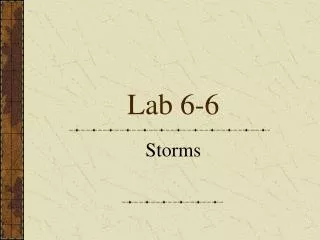
Lab 6-6 Storms Vocabulary Prevailing westerlies- typical west wind at this latitude. Trade winds- prevailing wind from east below florida’s lat. Jet stream- high altitude, high speed “river of air.” DVD Weather- Wind CHP 4 22:00 Storm track- path of a storm.
1.08k views • 62 slides

Lab 6-6. Storms. Vocabulary. Prevailing westerlies- typical west wind at this latitude. Trade winds- prevailing wind from east below florida’s lat. Jet stream- high altitude, high speed “river of air.” DVD Weather- Wind CHP 4 22:00 Storm track- path of a storm.
1.13k views • 62 slides

Institute of Food and Agricultural Sciences (IFAS) . Biogeochemistry of Wetlands Science and Applications. ADVANCES IN BIOGEOCHEMISTRY. Wetland Biogeochemistry Laboratory Soil and Water Science Department University of Florida. Instructor : Patrick Inglett [email protected] .
837 views • 30 slides

Meaningful Use of Health IT: Laboratory Data Capturing and Reporting. Nikolay Lipskiy, MD, DrPH, MBA CDC, PHITPO. 6/6/2014. Speakers. E-mail: [email protected]. 6/6/2014. Background. Process
260 views • 14 slides

6-6. Classifying Data. Objective Classify data as either categorical or quantitative Understand the difference between discrete and continuous. Lesson Quiz: 6-5 Answers .
394 views • 15 slides
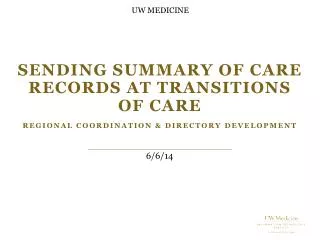
UW MEDICINE . Sending Summary of Care Records at Transitions of Care Regional Coordination & Directory Development. 6/6/14. UW Medicine Meaningful Use. Hospitals Northwest Hospital – Siemens HMC & UWMC – Cerner Valley - Epic Clinics Northwest Hospital – Siemens
264 views • 12 slides

Illustration 6/2-6/6 Livoti
Illustration 6/2-6/6 Livoti . Tues 5/27. Aim: How can you continue to work on your album cover illustration?. Do Now : review HW assignment and reflect on two kinds of illustration you enjoyed the most. HW : Fina l Illustration HW Assignment
290 views • 5 slides

PROMOTE TO RC IN YOUR FIRST 28 DAYS WITH 6-2-6!. 6-2-6. YOU.
177 views • 1 slides

Eph. 6:6 Not with eyeservice, as menpleasers; but as the servants of Christ, doing the will of God from the heart;. Col. 4:12 …that ye may stand perfect and complete in all the will of God. A man, a plan, a canal, Panama. Psalm 37:23
312 views • 11 slides

Pili. Nucleoid. Ribosomes. LE 6-6. Plasma membrane. Cell wall. Bacterial chromosome. Capsule. 0.5 µm. Flagella. A typical rod-shaped bacterium. A thin section through the bacterium Bacillus coagulans (TEM). ENDOPLASMIC RETICULUM (ER. Nuclear envelope. Flagellum. Rough ER.
574 views • 13 slides

Ch 6 Precipitation Titrations, Sec 6-5 and 6-6
Ch 6 Precipitation Titrations, Sec 6-5 and 6-6. Titration of a Mixture. e.g. A mixture of Cl - and I - is titrated with Ag + . Which halide precipitates out first? K sp AgCl = 1.8 x 10 -10 , K sp AgI = 8.3 x 10 -17. Measuring the Titration Curve in Precipitation Titrations. Fig 6-5.
2.12k views • 12 slides

6-6 Analytic Geometry
6-6 Analytic Geometry. y. y. y. Right Triangle. (a, b). (0, b). (0, 0). (0, 0). (0, 0). x. x. x. (b, c). (a, 0). (2a, 0). (a, 0). Coordinate Geometry uses actual points.
218 views • 7 slides

UW MEDICINE. Sending Summary of Care Records at Transitions of Care Regional Coordination & Directory Development. 6/6/14. UW Medicine Meaningful Use. Hospitals Northwest Hospital – Siemens HMC & UWMC – Cerner Valley - Epic Clinics Northwest Hospital – Siemens
294 views • 12 slides
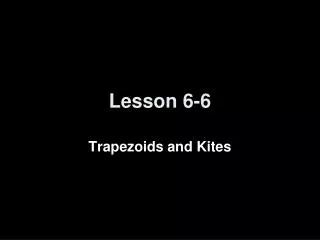
Lesson 6-6. Trapezoids and Kites. 5-Minute Check on Lesson 6-5. L. LMNO is a rhombus. Find x Find y QRST is a square. Find n if m TQR = 8n + 8. Find w if QR = 5w + 4 and RS = 2(4w – 7). Find QU if QS = 16t – 14 and QU = 6t + 11.
629 views • 16 slides

Lesson 6-6. The Pythagorean Theorem. Ohio Content Standards:. Ohio Content Standards:. Find the square root of perfect squares, and approximate the square root of non-perfect squares. Ohio Content Standards:.
360 views • 20 slides

ErFe 6 Sn 6
206 views • 10 slides

Unit 6 – Chapter 6
Unit 6 – Chapter 6. 6.1 – Discrete and Continuous Random Variables. Do you remember?. What is a probability distribution?. Example: Flipping Out!. Below is a probability distribution for flipping a coin four times and counting how many heads we see:
254 views • 15 slides

6-6. Volume of Prisms and Cylinders. Warm Up. Problem of the Day. Lesson Presentation. Pre-Algebra. Learn to find the volume of prisms and cylinders. Vocabulary. prism cylinder.
271 views • 26 slides

6-6. Fundamental Theorem of Algebra. Objectives. Use the Fundamental Theorem of Algebra and its corollary to write a polynomial equation of least degree with given roots. Identify all of the roots of a polynomial equation. Holt Algebra 2.
163 views • 13 slides
6+1 Writing Traits Google Slides presentation
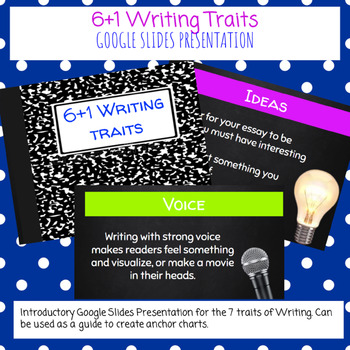
- Google Slides™
Also included in
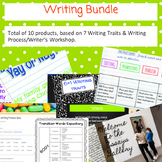
Description
This is a short & simple Google Slides presentation to introduce the 7 traits of Writing.
I use it when I introduce these concepts in my writing/composition block of ELAR & then we create anchor charts/tabs in their writing binders, where we insert resources or cheat sheets they can refer back to when they write a composition.
Questions & Answers
Teach like u mean it.
- We're hiring
- Help & FAQ
- Privacy policy
- Student privacy
- Terms of service
- Tell us what you think

IMAGES
VIDEO
COMMENTS
Presentation: the overall appearance of the work; We also must remember that the writing process is just that, a process. Its beginning, middle, and end flow like a river, always going somewhere but often taking its own sweet time to get there. ... In my book, 6+1 Traits of Writing: The Complete Guide for Primary Grades, I offer a few more ...
The additional writing trait (6+1) addresses the presentation of the writing itself. In written pieces, this includes handwriting, penmanship, writing on a line, letter formation, and overall legibility. In digital products, it includes the use of typography, color, graphics, images, proportions, margins, white space, etc.
The 6+1 Trait Writing Model is an instruction and assessment tool designed by teachers to help teachers teach their students how to write. According to this model, there are six key traits that make up quality writing and an extra traits. The six traits are ideas, organization, voice, word choice, sentence fluency, and conventions.
the instruction of writing. The Six Traits of writing are Voice, Ideas, Presentation, Conventions, Organization, Word Choice, and Sentence. Fluency. It creates a common vocabulary and guidelines for teachers to use. with students so that they become familiar with the terms used in writing. It.
The 6+1 Trait® Writing analytical model for assessing and teaching writing is made up of 6+1 key qualities that define strong writing. These are: Ideas, the main message; Organization, the internal structure of the piece; Voice, the personal tone and flavor of the author's message; Word Choice, the vocabulary a writer chooses to convey meaning;
The six key characteristics that define high-quality writing are: Please note that while this method is often called the 6 + 1 Trait Model, the plus one "presentation" trait is largely optional as it is a characteristic of the overall product and not the writing itself. This trait will not be described further here.
In 6+1 Traits of Writing: The Complete Guide: Grades 3 and Up, I outline how the 6+1 TRAIT model is more than an approach to teaching and assessing writing.It's a vocabulary that teachers use to describe their vision of what good writing looks like—any kind of writing. Whether it's a story about a quirky music teacher, an essay on the effects of global warming, or a persuasive piece on ...
3 The writer seems sincere, but not fully engaged or involved. The writing has discernable purpose, but is not compelling. The writing attempts to connect with the audience in an earnest, pleasing, but impersonal manner. The writer seems aware of a purpose, and attempts to select content and structures that reflect it.
The 6+1 TRAIT model works by allowing teachers to pinpoint students' strengths and weaknesses in ideas, organization, voice, word choice, sentence fluency, conventions, and presentation, and focus instruction. Like the groundbreaking guide for grades 3 and up (opens in a new window), this new book contains scoring guides, sample papers, and focus lessons for each trait, but framed to address ...
The sixth one down specifically focuses on the 6+1 Traits of Writing. The link provides many other PowerPoint presentations concerning the writing process that can also be helpful in classroom instruction. Click on the PowerPoint of your choice. It will be brought up in a Microsoft PowerPoint presentation. Type of Resource: Instructional ...
Trait Seven: Presentation The Form and Layout "Presentation zeros in on the form and layout -- how pleasing the piece is to the eye." (6+1 Traits of Writing by Ruth Culham) Presentation encompasses the visual elements of writing, including font choice, spacing, alignment, indentation, and overall formatting.
The 6+1 Trait® Writing Model forWriting Model for Assessment and Instruction 4. Word Choice Word choice is the use of rich, colorful, precise language that moves and enlightens the reader. 5. Sentence Fluency Sentence fluency is the rhythm and flow of the language, the sound of word patterns, the way in which the writing plays to
The 6 traits of writing are voice, ideas, conventions, organisation, word choice and sentence fluency. Sometimes presentation is also included as an extra trait. In this case, we refer to this list as the '6 + 1' traits of writing or as the 7 traits of writing. The 6 traits of writing model can be used to teach almost any form of creative ...
Why has the 6+1 TRAIT model had such a tremendous impact on writing instruction? Because it works. It allows teachers to pinpoint students' strengths and weaknesses in ideas, organization, voice, word choice, sentence fluency, conventions, and presentation, and focus instruction. Now Culham turns her expert eye to our youngest students.
The document outlines the 6 + 1 Traits of Writing model which provides a common framework for teachers to assess student writing based on the traits of Ideas, Organization, Voice, Word Choice, Sentence Fluency, Conventions, and Presentation. It describes how each trait is defined and how teachers can help students improve in each area through ...
CristinaSaraT. The document outlines the 6 + 1 Traits of Writing model which provides a common framework for teachers to assess student writing based on the traits of Ideas, Organization, Voice, Word Choice, Sentence Fluency, Conventions, and Presentation. It describes how each trait is defined and how teachers can help students improve in each ...
The document also introduces the Six Traits Analytic Model for assessing writing and provides information about each of the six traits: Ideas, Organization, Voice, Word Choice, Sentence Fluency, and Conventions. Read more. 1 of 23. Download now. Download to read offline. 6 + 1 Writing Trait - Download as a PDF or view online for free.
The 6+1 TRAITS of Writing Unit includes PowerPoint Presentations that cover an overview of the 6+1 TRAITS of Writing, the Ideas Trait, the Voice Trait, the Word Choice Trait, the Organization Trait, and the Presentation Trait. All presentations describe the Trait, teach students how to put the Trai
Sometimes, presentation is included as an extra trait. ... 6 + 1 Writing Traits Resource Pack. Editing and Proofreading Checklists Years 5-6. Student Writing Assessment Rubric - Generic. English Progression Map. Year 1-6 Reading, Writing, Speaking and Listening Assessment Spreadsheet.
Presentation Transcript. 6 + 1 Writing Traits Lindsey Shreck Towson University Spring 2012. Objectives Participants will…. • Use words and pictures to define the 6 + 1 traits of writing • Identify strategies to use in the classroom to support the 6 + 1 traits of writing • Use the 6 + 1 traits rubric to assess sample writing pieces ...
Total of 10 products, based on 7 Writing Traits & Writing Process/Writer's Workshop.1 Google Slides Presentation to introduce 7 Writing Traits1 Google Slides Presentation for students to rate real world student sample essays1 Google Slides Presentation to introduce & visualize what it means. 10. Products. $14.72 $18.40 Save $3.68.
1 6+1 Trait™ Writing Assessment Scoring Guide! IDEAS! ORGANIZATION! VOICE! WORD CHOICE! SENTENCE FLUENCY! CONVENTIONS! PRESENTATION WOW! Exceeds expectations ... 6 SENTENCE FLUENCY The writing has an easy flow, rhythm, and cadence. Sentences are well built, with strong and varied structure that invites expressive oral reading. ...
Use this handy display poster to introduce the last 6+1 writing trait, Presentation, to your students. This resource aligns with Australian Curriculum Literacy topics AC9E3LY06, AC9E4LY06, AC9E5LY07 and AC9E6LY06. Twinkl Australia 3 - 4 Australian Curriculum Resources English Literacy Writing Displays. Ratings & Reviews.